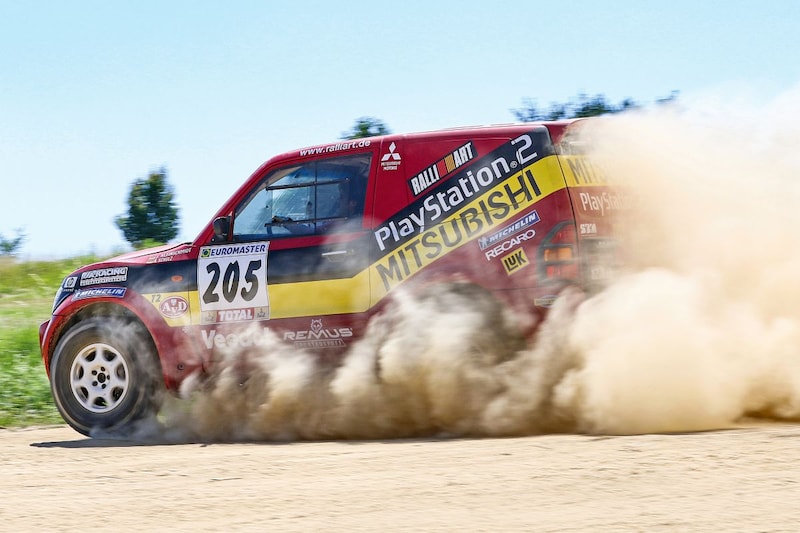


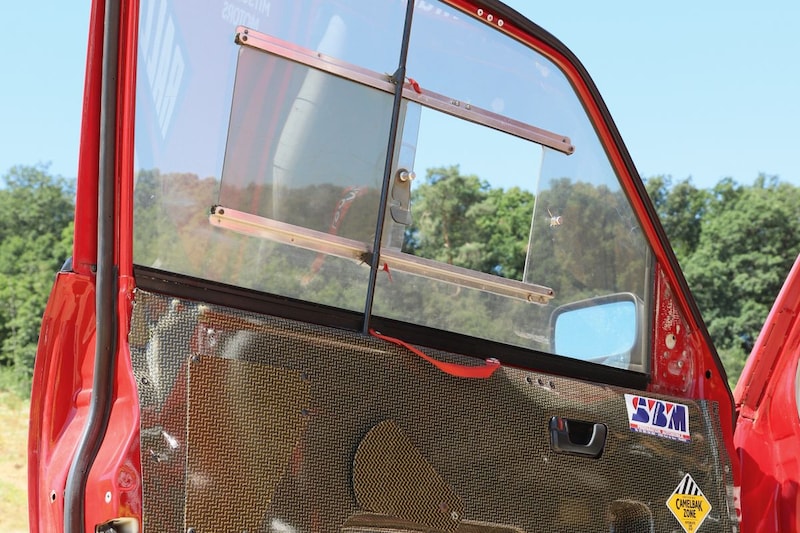
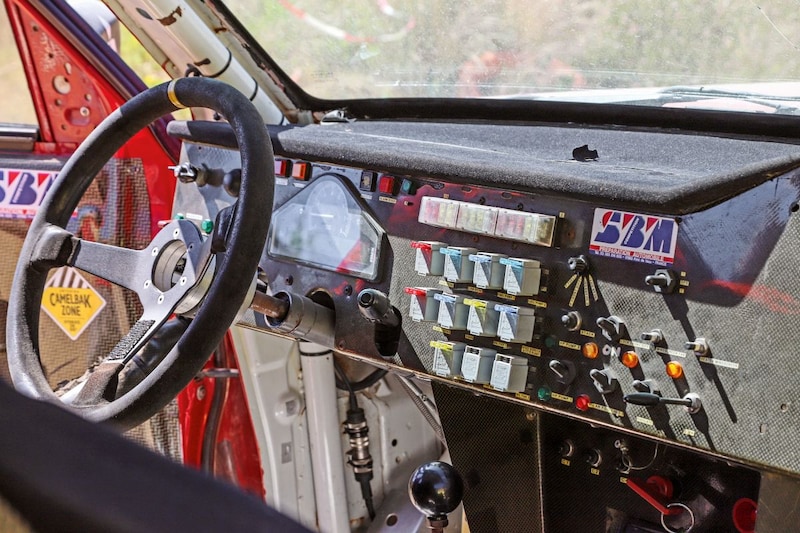


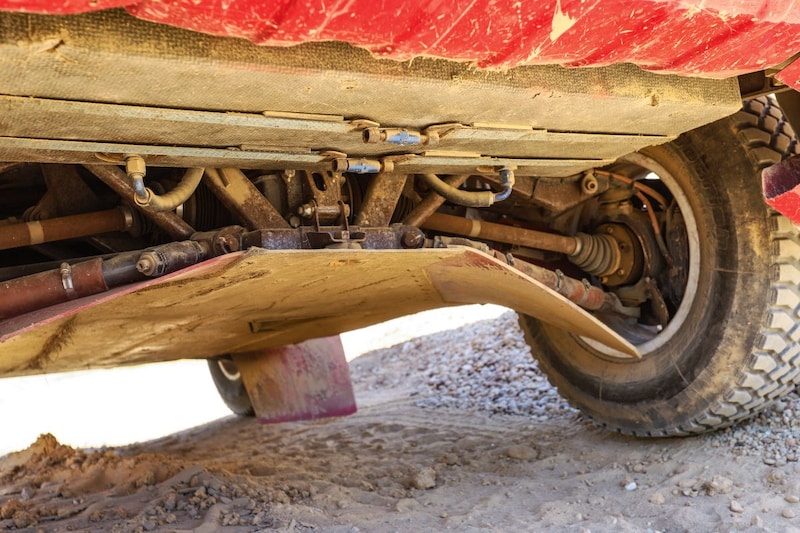
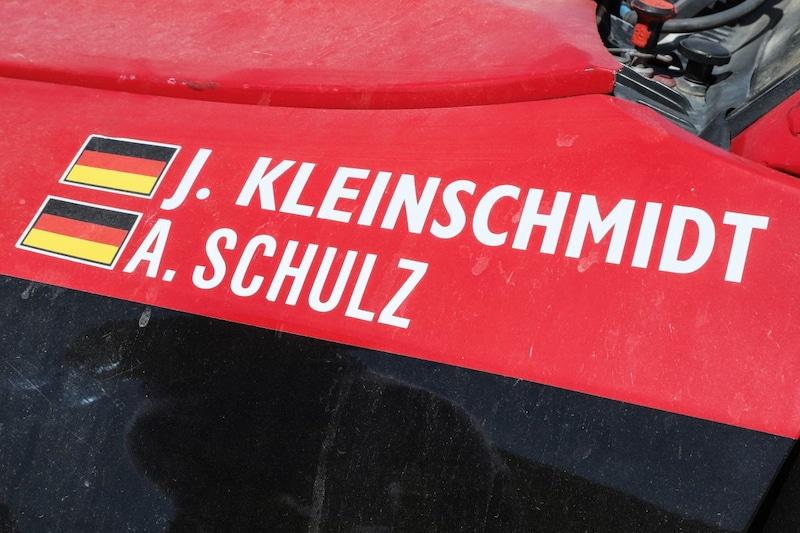
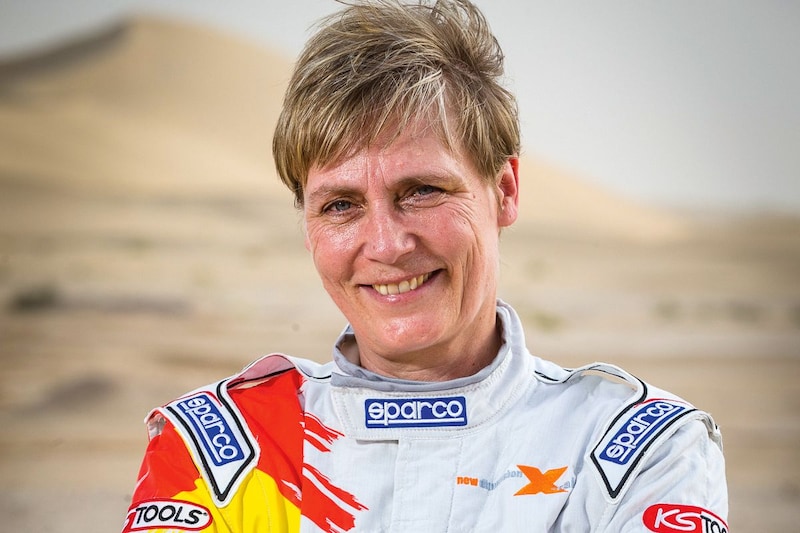
Mitsubishi rally cars were practically unbeatable in the 1990s and just after the turn of the century. We hit the road with the legendary Pajero of Dakar winner Jutta Kleinschmidt, who crossed the finish line first in 2001.
Yes, it really is: the 2001 rally Pajero which served as an example of a whole series of model cars and which became immortal because Jutta Kleinschmidt became the first winner of the Dakar rally with this car. She also managed to win the race with a car from the year before, which was 200 kilos heavier than its successor. The Pajero looks short, high, broad-shouldered and almost square. The car that was feared in the rally scene at the time seems to be smiling at us. However, getting behind the wheel is quite a task: first squeeze your right leg over the protective X-shaped tube profile, then bend your upper body and head forward, plop your butt on the seat and pull your left leg behind it. We spontaneously get the feeling that we have sat down in a vice. The doors, bonnet and tailgate are made of lightweight composite material. The exterior mirrors are miniscule, unlike the floppy ears of the standard Pajero, which features mirrors that wouldn’t look out of place in a bathroom. The door handle on the inside, however, is original again, as is common on Dakar cars to this day.

Like all rally cars, starting is also quite cumbersome in this car: first you have to turn the central switch on the center console and then bring numerous pumps to life with a small rotary knob in the top left. Then the Japanese 4×4 hero comes buzzing to life. After we hit the start button, a growling blorp blorp comes out of the exhaust. The legend is awake again. The sintered metal clutch with its ultra-short pedal travel requires a trained left leg. We put in second gear and after releasing the clutch pedal, the successful four-wheel drive storms through the sand. This clutch is a real on / off clutch, as is common in the rally world. Dosing is practically impossible, but for good reason. The clutch is small and does not like slipping. This gun does not have a low gearing, the transmission supplier has provided a short transmission of the first and second gears of the six-speed gearbox instead. A combination of 260 hp, low weight and an extremely short gear ratio provides a particularly enthusiastic acceleration. It is accompanied by a sound that is reminiscent of the heavy metal songs from the same era. It’s so bonkers that your ears are begging for mercy.
Tidy and sober
Modern rally cars look like racing computers that continuously analyze the data from a whole series of pressure and temperature sensors and thus monitor the well-being of the various components. Even the boost pressure and the temperature in the differentials are monitored, and everything is duplicated. The 2001 Dakar-Pajero looks tidy and sober compared to those cars, which was probably also the basis of its endurance. With the rotary switches at the top right of the dashboard, physical engineer Jutta Kleinschmidt, then 38 years old, could request the temperatures and pressure values via one small display. Warning messages were also shown on the same display. Underneath is a round tachometer, and that was it.

Today, sequential rally transmissions are common: the reverse gear is at the front, for putting in the remaining gears you can pull the lever back in a single movement, just like on a motorcycle. The Pajero also has an H-pattern transmission with an improvised-looking feature that prevents you from accidentally engaging the reverse gear. If you want to reverse, you must pull a steel cable up with your right hand and engage reverse gear with your left hand. Where at rallies nowadays you mainly see cars with a tubular frame and a body made of glass fiber-reinforced plastic that largely resembles that of the production model, this rally car is still fairly close to the series product. You also found the bodywork and the basic construction of the engine in the regular Pajero’s.

The V6 comes from the production model, but the power has been increased from 203 to 260 hp. The six-cylinder was also equipped with stronger axles and bearings. With the civilian Pajero, Mitsubishi had challenged fate at the time with an early variant of the direct petrol injection system: the internal pollution of the engine was above average. Sometimes you will be punished if you run ahead of the troops. The Dakar racer thus received a conventional injection system.
Ravages of time
From the interior, the tire pressure could be reduced to a minimum of 0.7 bar to prevent sinking into the sand, and then increased to 2.5 bar again. There was no longer a place on the racing wheel for the horn, you can now operate it with a toggle switch on the dashboard. The test of time has done its job, because not everything works anymore. For example, the coating has come off in the 470 liter petrol tank. The employees of the factory museum quickly had a second petrol tank placed in the place where the spare wheels were normally available: in the luggage compartment. The permanent four-wheel drive with automatic viscose and manual locking, which was also found on the production models, can no longer be engaged and various differential locks can no longer be switched off. And of the six gears of the past, only the first three are still working. It is becoming increasingly difficult to find parts for this Dakar veteran. Fortunately, you can still drive with this rally hero, he is not just gathering dust in a museum.
After the driving session, we were even more impressed by Mrs. Kleinschmidt’s driving qualities. That metallic sound, the hard blows that the chassis delivers, no power steering, no air conditioning. It must be a hell of a job to blast through Africa all day in the scorching heat. At the end of our test drive, the Donnere dampers no longer do what they were once made for. Even guys made of steel get old at some point.
The winner speaks
Jutta Kleinschmidt won the Dakar Rally twenty years ago with her Mitsubishi Pajero without air conditioning or power steering. She looks back with visible pleasure on her hard-won historic victory.

Jutta Kleinschmidt
With a weight of 1,790 kilos, your 2001 car was not exactly light – wasn’t that a big disadvantage compared to the light buggies? They usually weighed less than 1,200 kilos.
“Yes, but my Pajero had four-wheel drive and the buggies were not. The four-wheel drive makes such a big difference that the competition’s regulators gave the buggy builders more options in other areas, such as with regard to allowable suspension travel. And that extra freedom is still food for discussion to this day.
The Dakar-Pajero felt heavy in the nose during our ride. Is that just because there were no spare wheels in the back and there is a much smaller tank in the back?
“Of course the weight distribution makes a difference, but the car did feel a bit heavy in the nose during races. However, that could be improved considerably by adjusting the suspension setting. ”
Does the 3.5-liter V6 under the hood still have a lot in common with the one from the production model? At the time, the production Pajero was equipped with an early variant of the direct injection system, which led to internal contamination.
“The car had a prototype engine, which, although based on the standard engine, had a higher power output and was modified in many ways. Today only power sources from series production can be used. ”
The Pajero had neither power steering nor air conditioning, but you drove it casually through Mali and Mauritania. How did you deal with the heat?
“The ventilation with the small sliding windows is amazingly effective. However, I have never used a cooled overall in 24-hour races – and I have not missed that either. Apparently I can handle heat well. ”
What do you think when you see the rally cars of today inside? A deluge of digital displays, even the charge air and the temperatures in the differentials are monitored. Your victory car doesn’t have any of that, we discovered.
“You don’t need many of those things while driving and you only use them when problems arise. What makes a big difference, however: today’s rally cars are completely redesigned, while our Pajero is built on the basis of the standard body. ”
Are the Dakar drivers having it easier now than then?
“The cars are easier to drive. If only because the H-pattern manual gearboxes have been replaced by sequential gearboxes and the drivers often no longer even have to press the clutch pedal to change gears. If you compare the rally cars of today with those of then, the contemporary ones feel like go-karts. ”
When the Dakar rally was moved to South America, many participants felt that the focus had shifted too much to speed. How do you feel about that?
Average speeds are comparable to 2001. Navigation was easier in South America due to the large number of spectators and the fact that there were only a few pure off-road routes. Now that the rally is being held in Saudi Arabia, navigating is again a greater challenge because the participants no longer receive the road book one night in advance and can therefore no longer work out the route via Google Earth. They only get the route at the start as a digital road book. ”